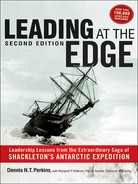Get ready for the next adventure at The Edge!
Dusk was coming on and I was at the end of my tether and thinking to myself, “If this continues, I can’t keep going like this. And there’s no one else that can steer this damn boat, so we’re in serious trouble.”
—Ed Psaltis, Skipper, AFR Midnight Rambler
Arthur Psaltis watches the boat’s digital readout as the wind speed races from thirty-five knots, to forty, and then forty-five knots. At sixty knots, the readout suddenly goes blank. Arthur stares at the empty screen. Then it hits him: The metal fitting that holds the wind meter on top of the mast has been torn off, rendering the instrument useless.
The next blast of wind flattens the boat, driving its mast into the water and flooding the cockpit. As the crew has done so many times in practice, side by side on the rail with their backs to the sea, they calmly take in the main sail. They know what they have to do. If the sail stays up, the boat could be rolled 360 degrees and they might never recover.
Conditions are treacherous and getting worse by the minute. The noise is the most frightening part. It comes as a high-pitched scream, like an old-fashioned kettle boiling furiously. The wind—reaching speeds of nearly ninety miles per hour—howls around them, and the waves rise higher than the fifty-foot mast, dwarfing the thirty-five-foot boat.
The heavy rain and spew from the waves spray the sailors on deck, pelting their faces like gravel, and the constant noise makes talking nearly impossible. The crew can communicate only by cupping their hands around their mouths and shouting into each other’s ears. They slap the hull of the boat to warn those below deck of oncoming big waves.
The men below deck are fighting a different battle. They can see nothing of what is happening topside and find themselves in a constant state of anxiety. As Ed expertly steers the boat up the face of the massive waves, the men exhale each time the boat slides down the other side unscathed. It is an extraordinary feat of seamanship.
But not every time. When Ed miscalculates, the boat flies off the wave and hangs in midair until it hits the trough between the waves. The impact is like crashing into a block of cement. Trapped below, the crew waits to see if the boat will explode, the weight of the rigging ramming the mast through the hull like a pile driver. It is a horrible feeling knowing that the boat might fill with water and sink in an instant.
As the boat shoots off the back of one towering wave, Chris Rock-ell, a tough, rugby-playing New Zealander, is launched from his seated position. He flies through the air, crashing into an exposed bolt that is sticking through the overhead of the cabin. Chris falls backward and his face turns red, covered with blood.
Terrified that his injury will force the team to quit the race, Chris sticks his fingers into the wound to see if he touches “hard or squishy.” Relieved to find his skull intact, he insists that the boat continue on and not pull out of the race on his account. Concussed and barred from going on deck, Chris carefully positions his weight on the high side of the boat to act as ballast.
The crew members are literally fighting for their lives, and the worst is yet to come. They are competing in what will become one of the most dangerous and historic offshore ocean races in history.
* * * * * *
Into the Storm: Lessons in Teamwork from the Treacherous Sydney-to-Hobart Ocean Race recounts the story of the courageous crew members of AFR Midnight Rambler, winners of the 1998 Sydney Hobart Yacht Race. Their stunning victory, and the teamwork that made it possible, hold valuable lessons for success in today’s demanding environment.
Organizations are always faced with ambiguity and uncertainty, but the current level of turbulence is unprecedented in recent memory. By studying leaders and teams facing extreme challenges, the authors have identified a set of core strategies that are critical to success at The Edge.
It’s hard to imagine a better place to test these strategies than the iconic Sydney Hobart Yacht Race. This 723-mile, deepwater challenge—often called the “Everest” of offshore ocean racing—is considered one of the toughest in the world. Unpredictable weather and seas make each race demanding, but the 1998 race proved to be the most perilous in the race’s sixty-five-year history.
As the fleet of 115 boats sailed down the coast of Australia, they were hit by an unexpected weather bomb—a massive storm that created eighty-foot waves and near hundred-mile-an-hour winds. Six sailors perished in the maelstrom, and another fifty-five were saved in what became the largest search-and-rescue operation in Australia’s history.
While many boats tried to maneuver around the storm, the crew of AFR Midnight Rambler chose to head directly into its path. After battling mountainous waves and hurricane-force winds, they arrived safely in Hobart, three days and sixteen hours later.
The decision to head into the eye of the storm, along with extraordinary tenacity, optimism, courage, and teamwork, enabled this team of “amateurs” to beat professionals sailing much larger and better-financed boats. Ed Psaltis and his crew of six were proclaimed overall winners and awarded the coveted Tattersalls Cup. They were the smallest boat in ten years to win the race.
What were the factors underlying this stunning victory? How has the team sustained its remarkable pattern of winning for more than a decade? This inspiring book answers these questions and provides concrete strategies for building exceptional teams in extraordinary times.
